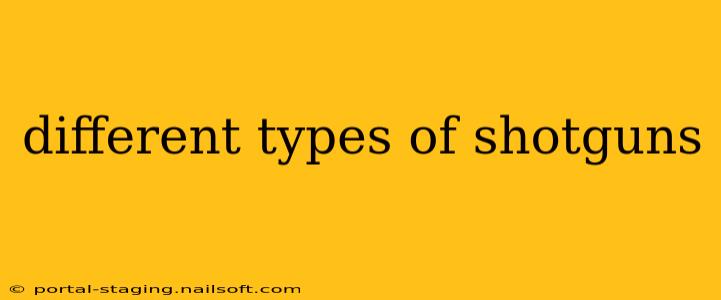Shotguns, known for their versatility and stopping power, are popular firearms for hunting, sport shooting, and home defense. But with a wide variety of models available, choosing the right shotgun can feel overwhelming. This guide breaks down the different types of shotguns, helping you understand their features and applications.
Classifying Shotguns: Gauge and Action
Before diving into specific types, it's crucial to understand the two primary classifications: gauge and action.
Gauge: The Size Matters
Gauge refers to the diameter of the shotgun's barrel. The lower the number, the larger the bore diameter. Common gauges include:
- 10 Gauge: The largest commonly used gauge, known for its immense power, often used for waterfowl hunting.
- 12 Gauge: The most popular gauge, offering a balance of power, versatility, and readily available ammunition.
- 16 Gauge: A lighter recoiling option than 12 gauge, suitable for smaller framed shooters or those seeking less recoil.
- 20 Gauge: Even lighter than 16 gauge, ideal for beginners, smaller game hunting, and youth shooters.
- 28 Gauge: The smallest commonly used gauge, offering the mildest recoil. Popular for upland game hunting and sporting clays.
- .410 Bore: Technically not a gauge, but often grouped with them. It's the smallest commonly available shotgun bore, known for its extremely light recoil.
Action: How it Works
The action type describes the mechanism by which the shotgun loads and fires shells. The most common types include:
- Pump-Action: Manually operated by sliding the forearm forward and backward to eject spent shells and load new ones. Reliable, durable, and relatively inexpensive.
- Semi-Automatic: Uses the recoil energy from firing to automatically cycle the action, loading the next shell. Faster firing rate than pump-actions.
- Bolt-Action: Manually operated with a bolt that loads and ejects shells. Less common for shotguns, but offers precise operation.
- Break-Action (Over-and-Under & Side-by-Side): The barrel hinges open at the breech for loading. Over-and-under shotguns have barrels stacked vertically, while side-by-side shotguns have barrels placed horizontally. Known for their elegance and accuracy.
Types of Shotguns Based on Purpose
The best shotgun for you depends heavily on its intended use. Here are some popular categories:
Hunting Shotguns
Hunting shotguns are categorized by the type of game they're designed for:
- Waterfowl Shotguns: Typically large-gauge shotguns (10, 12) with long barrels for long-range shooting.
- Upland Game Shotguns: Lighter gauges (20, 28, .410) are favored for their reduced recoil and maneuverability.
- Turkey Shotguns: Often feature specialized chokes and larger gauge for taking down larger birds.
Home Defense Shotguns
Home defense shotguns prioritize stopping power and reliability in close-quarters situations. Pump-action and semi-automatic shotguns are common choices due to their quick reloading capabilities. Shorter barrels (18-20 inches) are also prevalent.
Sporting Clays Shotguns
Sporting clays shotguns are designed for competitive shooting. These often feature adjustable stocks, higher-end components, and are usually over-and-under or semi-automatic.
Tactical Shotguns
Tactical shotguns are purpose-built for law enforcement and military use. They frequently feature specialized features like shorter barrels, pistol grips, and tactical accessories.
Choosing the Right Shotgun
Selecting the right shotgun requires considering several factors:
- Intended Use: Determine the primary purpose (hunting, home defense, sport shooting).
- Gauge: Choose a gauge that balances power, recoil, and your physical capabilities.
- Action Type: Consider the reliability, speed of operation, and learning curve of different action types.
- Barrel Length: Shorter barrels are better for close-range situations, while longer barrels offer better accuracy at longer ranges.
- Budget: Shotguns range in price from budget-friendly to high-end models.
This guide provides a foundational understanding of the different types of shotguns available. Always prioritize safety and familiarize yourself with proper handling and usage before using any firearm. Remember to consult with experienced shooters and professionals to make an informed decision based on your individual needs and preferences.
